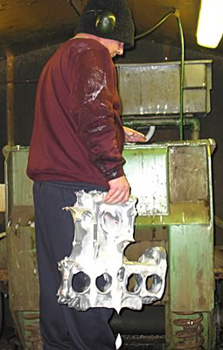How we do it...
Clean aluminium engine components are achieved using chemistry, vapour blasting and mass vibration. The combined effect of each process will provide a new, as cast finish with a degree of lustre.

Plastic plugs ranging from 2mm up to 150mm are inserted into blind holes, oil ways and bores before cleaning. Immersion in two chemicals are necessary because zinc based die-castings contain other elements as well as aluminium. They oxidize and form grey patches on the surface. Aluminium oxide is white. Chemical reaction dissolves the oxides
Difficult stains and resins are cut from the surface using sharp media within a wet blast cabinet set at a low pressure. Vapour blast cleaning of a casting may cause glass media to impregnate the internal surface. Under the influence of engine harmonics, heat and pressure the shards release from the casting into the engines oil. This failure is caused by cavitation. Air bubbles collapse and implode creating a negative pressure. For this reason we finish the castings using a mass vibration process. As a result, the inside shines as much as the outside. Finally each clean casting is placed into another machine containing ceramic ball bearings and lanolin. The ball bearings cascade over the surface of the casting gently burnishing it and changing the finish from white to lustrous aluminium. The finish is uniform and the small media size ensures that nooks and crannies are similar to the main surface.
The eighteenth century technique for polishing objects is easier to understand than its modern day equivalent. Imagine a rotating cement mixer full of pebbles into which a rough casting is placed. Eventually the casting will be smoothed by the pebbles, resulting in shine.
Polishing
Aluminium castings viewed through the microscope show a mountainous landscape of peaks and troughs. Brilliant reflective surfaces are achieved when the distance between the peaks and troughs is reduced. This is termed contour lean average (CLA).
The CLA can be reduced on flexible belt sanders and scurfing mops. Fine finishing is possible using varying grades of soap after the first two processes.
The rates quoted for polishing include a pre-clean and ceramic burnish of the internal surfaces. Thorough cleanliness ensures that the polisher's fingers do not transfer oil or grease to the polishing mop.
Preparing castings

In order that we can complete your job within two weeks it is essential that all steel components be removed. Exceptions to this are cylinder liners and valve guides that remain in position and are protected.

